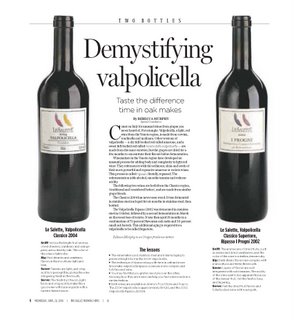{ Thanks to Rebecca Murphy of the Dallas Morning News }
Demystifying valpolicella wines - Taste the difference time in oak makes
Dallas Morning News ~Wednesday, April 26, 2006
By REBECCA MURPHY / Special Contributor to The Dallas Morning News
Count on Italy for unusual wines from grapes you never heard of. For example: Valpolicella, a light, red wine from the Veneto region, is made from corvina, rondinella and molinara. Other versions of valpolicella – a dry full-bodied red called amarone, and a sweet full-bodied red called recioto della valpolicella – are made from the same varieties, but the grapes are dried for a few months to concentrate their flavors before fermentation.
Dallas Morning News ~Wednesday, April 26, 2006
By REBECCA MURPHY / Special Contributor to The Dallas Morning News
Count on Italy for unusual wines from grapes you never heard of. For example: Valpolicella, a light, red wine from the Veneto region, is made from corvina, rondinella and molinara. Other versions of valpolicella – a dry full-bodied red called amarone, and a sweet full-bodied red called recioto della valpolicella – are made from the same varieties, but the grapes are dried for a few months to concentrate their flavors before fermentation.
Winemakers in the Veneto region have developed an unusual process for adding body and complexity to light red wine: They referment it with the sediment, skins and seeds of their more powerful and expensive amarone or recioto wines. This process is called ripasso, literally, repassed. The refermentation adds alcohol, smooths tannins and reduces acidity.
The following two wines are both from the Classico region, (traditional and considered better), and are made from similar grape blends.
The Classico 2004 has never seen wood. It was fermented in stainless steel and aged for six months in stainless steel, then bottled.
The Valpolicella Ripasso 2002 was fermented in stainless steel in October, followed by a second fermentation in March on the sweet lees of recioto. It was then aged 18 months in a combination of 70 percent Slavonian oak casks and 30 percent small oak barrels. This additional aging is required for a valpolicella to be called Superiore.
Le Salette, Valpolicella Classico 2004
Sniff: Notice the bright fruit aromas of red cherries, cranberry and orange peel, untouched by oak. The color of the wine is light ruby.
Sip: Red cherries and cranberry flavors in the mouth are light and lean.
Savor: Tannins are light, and crisp acidity is perceptible, giving the wine a lingering finish in the mouth.
Serve: The fresh fruit flavors, light body and crisp acidity make this a good wine with tuna or pasta with a tomato-based sauce.
The following two wines are both from the Classico region, (traditional and considered better), and are made from similar grape blends.
The Classico 2004 has never seen wood. It was fermented in stainless steel and aged for six months in stainless steel, then bottled.
The Valpolicella Ripasso 2002 was fermented in stainless steel in October, followed by a second fermentation in March on the sweet lees of recioto. It was then aged 18 months in a combination of 70 percent Slavonian oak casks and 30 percent small oak barrels. This additional aging is required for a valpolicella to be called Superiore.
Le Salette, Valpolicella Classico 2004
Sniff: Notice the bright fruit aromas of red cherries, cranberry and orange peel, untouched by oak. The color of the wine is light ruby.
Sip: Red cherries and cranberry flavors in the mouth are light and lean.
Savor: Tannins are light, and crisp acidity is perceptible, giving the wine a lingering finish in the mouth.
Serve: The fresh fruit flavors, light body and crisp acidity make this a good wine with tuna or pasta with a tomato-based sauce.
Le Salette, Valpolicella Classico Superiore, Ripasso I Progni 2002
Sniff: The aromas are of dried fruits, such as raisins and dried cranberries, and the color of the wine is a darker, denser ruby.
Sip: Dark cherry flavors are complex with a smooth, round feel in the mouth.
Savor: Layers of flavors are well integrated with solid tannins. The acidity of the wine seems less apparent because of the denser fruit. Yet the finish is long and lingering.
Serve: Pair the dried fruit flavors and fuller bodied wine with roast pork.
The lessons
•The winemaker used stainless steel and minimal aging to preserve bright fruit in the 2004 Valpolicella.
•The technique of ripasso along with time in oak and more time make valpolicella ripasso a denser, more complex and full-flavored wine.
•You may find that you prefer one style over the other. Knowing how they are made can help you find wines made in a similar fashion.
Sniff: The aromas are of dried fruits, such as raisins and dried cranberries, and the color of the wine is a darker, denser ruby.
Sip: Dark cherry flavors are complex with a smooth, round feel in the mouth.
Savor: Layers of flavors are well integrated with solid tannins. The acidity of the wine seems less apparent because of the denser fruit. Yet the finish is long and lingering.
Serve: Pair the dried fruit flavors and fuller bodied wine with roast pork.
The lessons
•The winemaker used stainless steel and minimal aging to preserve bright fruit in the 2004 Valpolicella.
•The technique of ripasso along with time in oak and more time make valpolicella ripasso a denser, more complex and full-flavored wine.
•You may find that you prefer one style over the other. Knowing how they are made can help you find wines made in a similar fashion.
* * * *

